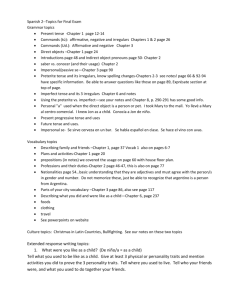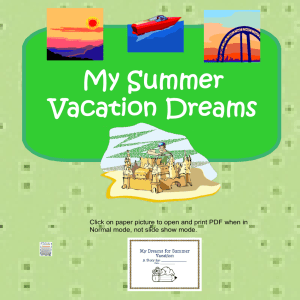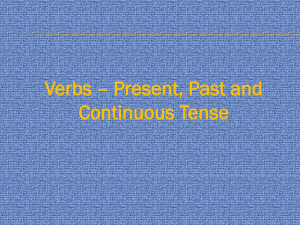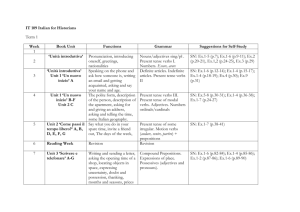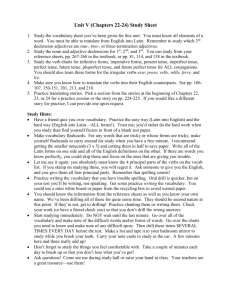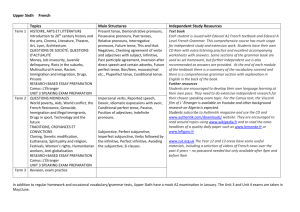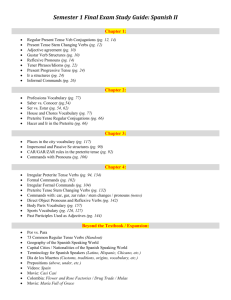at-a-glance-spanish-2 (new window)
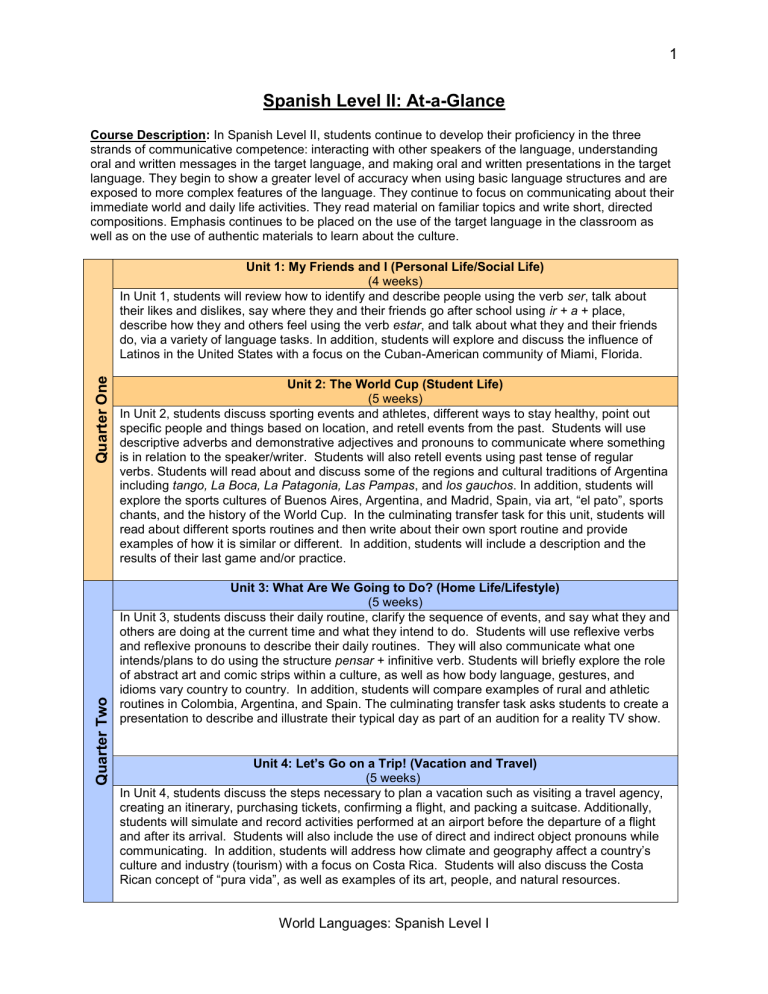
1
Spanish Level II: At-a-Glance
Course Description: In Spanish Level II, students continue to develop their proficiency in the three strands of communicative competence: interacting with other speakers of the language, understanding oral and written messages in the target language, and making oral and written presentations in the target language. They begin to show a greater level of accuracy when using basic language structures and are exposed to more complex features of the language. They continue to focus on communicating about their immediate world and daily life activities. They read material on familiar topics and write short, directed compositions. Emphasis continues to be placed on the use of the target language in the classroom as well as on the use of authentic materials to learn about the culture.
Unit 1: My Friends and I (Personal Life/Social Life)
(4 weeks)
In Unit 1, students will review how to identify and describe people using the verb ser , talk about their likes and dislikes, say where they and their friends go after school using ir + a + place, describe how they and others feel using the verb estar , and talk about what they and their friends do, via a variety of language tasks. In addition, students will explore and discuss the influence of
Latinos in the United States with a focus on the Cuban-American community of Miami, Florida.
Unit 2: The World Cup (Student Life)
(5 weeks)
In Unit 2, students discuss sporting events and athletes, different ways to stay healthy, point out specific people and things based on location, and retell events from the past. Students will use descriptive adverbs and demonstrative adjectives and pronouns to communicate where something is in relation to the speaker/writer. Students will also retell events using past tense of regular verbs. Students will read about and discuss some of the regions and cultural traditions of Argentina including tango, La Boca, La Patagonia, Las Pampas , and los gauchos . In addition, students will explore the sports cultures of Buenos Aires, Argentina, and Madrid, Spain, via art, “el pato”, sports chants, and the history of the World Cup. In the culminating transfer task for this unit, students will read about different sports routines and then write about their own sport routine and provide examples of how it is similar or different. In addition, students will include a description and the results of their last game and/or practice.
Unit 3: What Are We Going to Do? (Home Life/Lifestyle)
(5 weeks)
In Unit 3, students discuss their daily routine, clarify the sequence of events, and say what they and others are doing at the current time and what they intend to do. Students will use reflexive verbs and reflexive pronouns to describe their daily routines. They will also communicate what one intends/plans to do using the structure pensar + infinitive verb. Students will briefly explore the role of abstract art and comic strips within a culture, as well as how body language, gestures, and idioms vary country to country. In addition, students will compare examples of rural and athletic routines in Colombia, Argentina, and Spain. The culminating transfer task asks students to create a presentation to describe and illustrate their typical day as part of an audition for a reality TV show.
Unit 4: Let’s Go on a Trip! (Vacation and Travel)
(5 weeks)
In Unit 4, students discuss the steps necessary to plan a vacation such as visiting a travel agency, creating an itinerary, purchasing tickets, confirming a flight, and packing a suitcase. Additionally, students will simulate and record activities performed at an airport before the departure of a flight and after its arrival. Students will also include the use of direct and indirect object pronouns while comm unicating. In addition, students will address how climate and geography affect a country’s culture and industry (tourism) with a focus on Costa Rica. Students will also discuss the Costa
Rican concept of “pura vida”, as well as examples of its art, people, and natural resources.
World Languages: Spanish Level I
2
Unit 5: Tell Me About Your Vacation (Vacation and Travel)
(6 weeks)
In Unit 5, students will discuss where they went and what they did on vacation including different outdoor activities, lodging accommodations, and buying gifts and souvenirs. Initially, structures are limited to the present tense but the past tense is then introduced as students describe past events of a real or imaginary trip. Students will continue to explore the themes of climate and geography by comparing the weather, national parks, vacation destinations, and beverages of Costa Rica,
Chile, and Puerto Rico, as well as how art can reflect a culture’s values and customs . The final activity is a transfer task in which students will create and prepare an oral presentation supported by visuals and text to describe and share a recent vacation or trip (real or imagine) that they have taken.
Unit 6: How Does It Look? (Leisure Time)
(4 weeks)
In Unit 6, students discuss clothing, shopping, and personal needs, say whom things are for, and express their opinions using a variety of expressions and structures. Students will also identify a variety of places and specialty stores to shop. In addition, students will communicate opinions about fashion and shopping using gustar -like verbs, and explain what one does in contrast to what others do using forms of irregular first-person ( yo ) verbs in the present tense. Students will compare the traditions (indigenous, colonial, and modern) related to fashion and shopping in countrie s such as Puerto Rico and Perú, as well as address the question of how art reflects history and fashion through the work of Puerto Rican painter, José Campeche.
Unit 7: Filming at the Market (Leisure Time)
(5 weeks)
In Unit 7, students discuss items sold at a marketplace, describe ongoing events/situations, and use expressions of courtesy to converse with vendors; to ask for and talk about their products. The past tense is reintroduced and expanded with irregular and stem-changing verbs to describe past events and how long ago something happened.
Students will explore how the traditions (indigenous, colonial, and modern) and celebrations in countries such as Puerto Rico, Panamá, and Perú affect fashion, shopping, and production/sale of handicrafts. At the end of this unit, a transfer task asks students to go on a virtual shopping trip to purchase gifts of clothing and/or handicrafts for friends and family, and then describe and explain their purchases in an interview.
Unit 8: A Mexican Legend (Countries and Nationalities)
(6 weeks)
In Unit 8, students discuss legends and stories, focusing on those related to Mexican culture and the Aztec civilization. Story elements such as character and setting are described in detail using adjectives formed from the past participles of various verbs. Students also discuss legends and other stories they know that are part of cultural folklore used to explain natural phenomena such as fire. In describing past events such as childhood activities, students will use the preterite and imperfect tenses to reflect complete versus ongoing actions in the past. In addition, students will explore the theme of how history influences culture via the art, legends, celebrations, and archeology of Mexico, particularly the region of Oaxaca, and Nicaragua.

